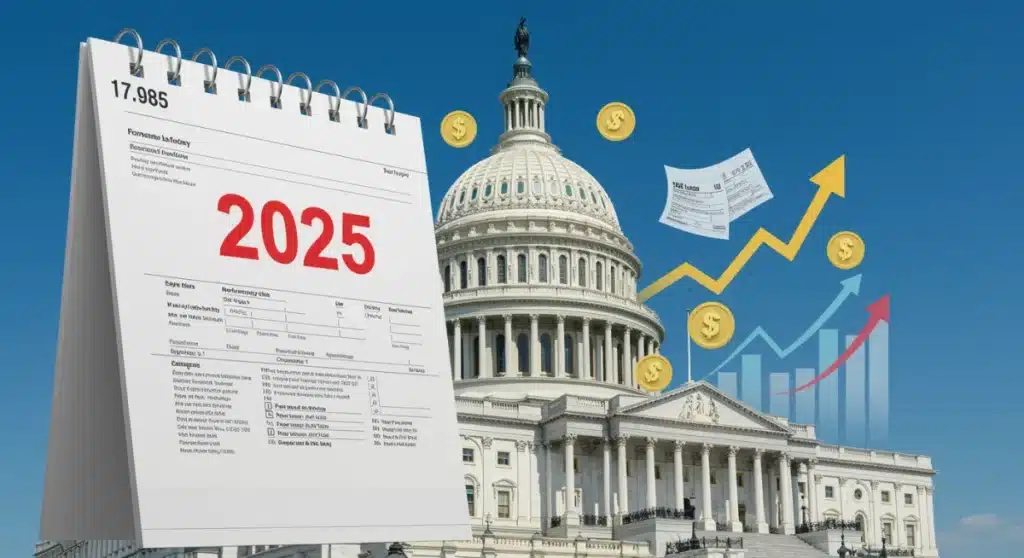Navigating 2025 Tax Law Changes: 5 Strategies for US Investors

Understanding and proactively adapting to the impending 2025 tax law changes is paramount for US investors seeking to optimize returns and preserve wealth in an evolving financial landscape.
As the year 2025 approaches, US investors face a landscape of potential tax law changes that could significantly impact their financial strategies. Proactive planning is not just advisable; it’s essential for anyone looking to optimize returns and preserve wealth. This article will guide you through Navigating 2025 Tax Law Changes: 5 Key Strategies for US Investors to Optimize Returns, ensuring you are well-prepared for what lies ahead.
Understanding the Looming 2025 Tax Sunset Provisions
The year 2025 represents a critical juncture for US tax policy, primarily due to the sunsetting provisions of the Tax Cuts and Jobs Act (TCJA) of 2017. Many of the individual income tax provisions enacted under the TCJA are set to expire at the end of 2025, reverting to pre-TCJA law unless Congress acts. This legislative cliff introduces significant uncertainty but also presents opportunities for astute investors to plan strategically.
The TCJA brought about substantial changes to individual tax rates, standard deductions, and various itemized deductions. Its expiration could mean higher marginal tax rates for many taxpayers, a reduction in the standard deduction, and changes to the alternative minimum tax (AMT). For investors, this translates into potential shifts in capital gains taxes, estate taxes, and other investment-related tax liabilities. Understanding these potential changes is the first step toward effective mitigation and optimization.
Key TCJA Provisions Set to Expire
Several crucial elements of the TCJA are slated for expiration, directly affecting investor planning. Being aware of these specific changes allows for targeted strategies.
- Individual Income Tax Rates: The current lower ordinary income tax rates are expected to revert to higher pre-TCJA levels. This could impact how investment income, such as interest and short-term capital gains, is taxed.
- Standard Deduction and Personal Exemptions: The increased standard deduction will likely decrease, and personal exemptions, which were zeroed out under TCJA, may return. This could affect overall taxable income.
- Estate and Gift Tax Exemption: The substantial increase in the estate and gift tax exemption is also set to expire. This particular change is critical for high-net-worth individuals and families engaged in wealth transfer planning.
- State and Local Tax (SALT) Deduction Cap: The $10,000 cap on SALT deductions, a contentious provision, is scheduled to disappear. Its removal could benefit investors in high-tax states by allowing them to deduct more state and local taxes.
The expiration of these provisions will necessitate a thorough review of existing financial plans. Investors should consider how these changes might alter their net investment income and overall tax burden, making adjustments to their portfolios and tax strategies well in advance of the new year.
Strategy 1: Proactive Capital Gains Management
Capital gains taxes are a significant consideration for investors, and the potential changes in 2025 could make proactive management more critical than ever. The current preferential rates for long-term capital gains and qualified dividends are tied to ordinary income tax brackets. If ordinary income tax rates increase, the thresholds for these preferential rates could also shift, potentially pushing more investors into higher capital gains tax brackets.
To mitigate the impact of these potential changes, investors should consider reviewing their portfolios now. This involves assessing unrealized gains and losses, and strategically timing the sale of assets. For instance, realizing long-term capital gains in 2024 might be advantageous if you anticipate being in a higher tax bracket or if capital gains rates themselves are expected to increase in 2025. Conversely, if you expect to be in a lower income bracket in 2025 due to other factors, deferring gains could be beneficial.
Tax-Loss Harvesting and Portfolio Rebalancing
One powerful tool in capital gains management is tax-loss harvesting. This strategy involves selling investments at a loss to offset capital gains and, potentially, a limited amount of ordinary income. Regularly reviewing your portfolio for opportunities to harvest losses can significantly reduce your tax liability, especially in years leading up to anticipated tax increases.
- Identify Underperforming Assets: Pinpoint investments that have declined in value but are unlikely to recover in the short term.
- Offset Capital Gains: Use realized losses to offset any capital gains you have recognized during the year.
- Offset Ordinary Income: If losses exceed gains, you can deduct up to $3,000 of the remaining loss against your ordinary income, carrying forward any excess losses to future years.
- Rebalance Your Portfolio: After selling, use the proceeds to purchase other investments that align with your long-term goals, ensuring your portfolio remains diversified and risk-appropriate.
Beyond tax-loss harvesting, rebalancing your portfolio becomes even more important. As tax laws shift, certain investments may become more or less tax-efficient. Adjusting your asset allocation to favor tax-advantaged accounts or investments with more favorable tax treatment can help optimize your after-tax returns. Consulting with a financial advisor can provide personalized guidance on these complex decisions.
Strategy 2: Maximizing Tax-Advantaged Retirement Accounts
Retirement accounts such as 401(k)s, IRAs, and Roth IRAs offer significant tax advantages that become even more valuable in the face of rising tax rates. These accounts allow investments to grow tax-deferred or tax-free, depending on the account type, and can be critical components of a comprehensive tax strategy for 2025 and beyond.
For traditional 401(k)s and IRAs, contributions are often tax-deductible, reducing your current taxable income. The earnings grow tax-deferred until retirement, when withdrawals are taxed as ordinary income. If you anticipate higher tax rates in 2025 and subsequent years, maximizing contributions to these accounts in 2024 can be a smart move, locking in deductions at potentially higher current rates.
Roth Conversions and Backdoor Roths
Roth accounts, on the other hand, are funded with after-tax dollars, but qualified withdrawals in retirement are entirely tax-free. This makes them particularly attractive if you expect to be in a higher tax bracket in retirement or if tax rates are generally increasing. The decision to convert a traditional IRA to a Roth IRA, known as a Roth conversion, requires careful consideration.

- Timing is Key: A Roth conversion involves paying taxes on the converted amount in the year of conversion. If you anticipate lower income or a temporary dip in tax rates before 2025, executing a Roth conversion now could be beneficial.
- Future Tax Rates: If you believe tax rates will be significantly higher in the future, a Roth conversion can effectively pre-pay your taxes at current, potentially lower, rates.
- Backdoor Roth IRA: For high-income earners who exceed the income limits for direct Roth IRA contributions, the backdoor Roth strategy remains a viable option. This involves contributing to a non-deductible traditional IRA and then immediately converting it to a Roth IRA.
The strategic use of Roth accounts can provide a powerful hedge against future tax increases, ensuring a portion of your retirement income is shielded from taxation. Discussing these options with a tax professional can help determine the optimal strategy based on your individual financial situation and projected tax outlook.
Strategy 3: Reviewing Estate and Gift Tax Planning
The potential sunset of the increased estate and gift tax exemption in 2025 is a critical concern for high-net-worth individuals. Under the TCJA, the basic exclusion amount for estate and gift taxes was significantly increased, allowing individuals to transfer substantial wealth free of federal estate and gift tax. If this provision expires, the exclusion amount will revert to approximately half of its current level, adjusted for inflation.
This impending change creates a limited window of opportunity for individuals to utilize the higher exemption amounts while they are still available. For families with significant assets, this means re-evaluating existing estate plans and considering accelerated gifting strategies. Making large gifts now, under the current higher exemption, can effectively remove assets from your taxable estate, potentially saving considerable amounts in future estate taxes.
Utilizing Current Exclusions and Trusts
Several strategies can be employed to leverage the current estate and gift tax landscape before potential changes take effect.
- Annual Gift Tax Exclusion: Remember that you can gift a certain amount to any individual each year without incurring gift tax or using up any of your lifetime exclusion. This amount is adjusted annually for inflation.
- Lifetime Gift Tax Exemption: For gifts exceeding the annual exclusion, your lifetime exemption is utilized. Maximize this exemption before it potentially decreases.
- Irrevocable Trusts: Establishing irrevocable trusts, such as Spousal Lifetime Access Trusts (SLATs) or Grantor Retained Annuity Trusts (GRATs), can be effective tools for transferring wealth out of your estate while retaining some control or income streams, depending on the trust structure.
- Generation-Skipping Transfer (GST) Tax Exemption: Similar to the estate and gift tax exemption, the GST tax exemption is also set to revert. Utilizing this exemption now can help preserve wealth for future generations free of GST tax.
Engaging with an estate planning attorney and a tax advisor is paramount to navigate these complex rules and ensure your wealth transfer strategies are aligned with your overall financial goals and the anticipated tax environment of 2025.
Strategy 4: Optimizing Investment Vehicle Choices
The choice of investment vehicle can have a profound impact on your after-tax returns, especially with changing tax laws. Different investment vehicles are subject to different tax treatments, and understanding these nuances is key to optimizing your portfolio for 2025. For example, municipal bonds, which offer tax-exempt interest income, may become even more attractive if ordinary income tax rates rise.
Consider the tax efficiency of your current holdings. Are you holding highly appreciated assets in taxable accounts that could be moved to tax-advantaged accounts if possible? Are you investing in funds that generate a lot of short-term capital gains or ordinary dividends in taxable accounts, which could be subject to higher taxes?
Evaluating Tax-Efficient Investments
A strategic review of your investment vehicles should focus on maximizing tax efficiency across your portfolio. This might involve shifting certain assets or increasing allocations to specific types of investments.
- Municipal Bonds: Interest earned from municipal bonds is generally exempt from federal income tax and, in some cases, state and local taxes as well, making them a strong choice for high-income investors in higher tax brackets.
- Exchange-Traded Funds (ETFs): Many ETFs are structured to be more tax-efficient than traditional mutual funds, often generating fewer capital gains distributions due to their unique redemption process.
- Qualified Opportunity Funds (QOFs): These funds allow investors to defer and potentially reduce capital gains taxes by investing in economically distressed areas. While complex, they can offer significant tax benefits under the right circumstances.
- Annuities: While not suitable for everyone, annuities offer tax-deferred growth. Income is only taxed upon withdrawal, which can be advantageous if you anticipate being in a lower tax bracket in retirement.
The key is to match the right investment vehicle with your individual tax situation and financial goals. A diversified approach that considers both pre-tax and after-tax returns will be most effective in the evolving tax landscape.
Strategy 5: Consulting with Financial and Tax Professionals
While understanding the potential changes and various strategies is crucial, navigating the complexities of tax law requires specialized expertise. The most effective strategy for Navigating 2025 Tax Law Changes: 5 Key Strategies for US Investors to Optimize Returns involves collaborating closely with qualified financial and tax professionals. These experts can provide personalized advice tailored to your unique financial situation, risk tolerance, and long-term goals.
Tax laws are dynamic, and interpretations can vary. A professional can help you understand the nuances of the expiring TCJA provisions, assess their specific impact on your portfolio, and identify opportunities for tax optimization that you might otherwise overlook. They can also help ensure that any strategies you implement comply with current and future regulations, minimizing the risk of unintended consequences.
Benefits of Professional Guidance
Engaging with professionals offers several distinct advantages in preparing for the 2025 tax changes.
- Personalized Tax Planning: Professionals can analyze your income, assets, liabilities, and future projections to develop a bespoke tax plan.
- Up-to-Date Knowledge: Stay informed about the latest legislative developments and potential last-minute changes that could impact your strategies.
- Minimizing Audit Risk: Ensure all your tax-saving strategies are compliant with IRS regulations, reducing the likelihood of audits or penalties.
- Holistic Financial Planning: Integrate tax planning with your broader financial goals, including retirement planning, estate planning, and wealth management.
- Strategic Implementation: Receive guidance on the proper execution and timing of various tax strategies, from Roth conversions to capital gains harvesting.
Do not underestimate the value of expert advice. The cost of professional consultation often pales in comparison to the potential tax savings and peace of mind gained from a well-executed tax strategy. Begin these conversations early to allow ample time for analysis and implementation before the 2025 changes take effect.
| Key Strategy | Brief Description |
|---|---|
| Capital Gains Management | Proactively time asset sales and utilize tax-loss harvesting to mitigate higher capital gains taxes. |
| Retirement Account Maximization | Increase contributions to 401(k)s, IRAs, and consider Roth conversions to leverage current tax rates. |
| Estate and Gift Tax Review | Utilize current higher exemption amounts through accelerated gifting and strategic trust planning. |
| Investment Vehicle Optimization | Shift to tax-efficient investments like municipal bonds or ETFs to reduce tax liabilities. |
Frequently Asked Questions About 2025 Tax Changes
The primary changes expected in 2025 stem from the sunsetting provisions of the Tax Cuts and Jobs Act (TCJA) of 2017. This includes potential increases in individual income tax rates, a reduction in the standard deduction, changes to the estate and gift tax exemption, and the expiration of the SALT deduction cap.
To prepare for potentially higher capital gains taxes, consider proactive capital gains management. This involves strategically timing the sale of assets, utilizing tax-loss harvesting to offset gains, and rebalancing your portfolio towards more tax-efficient investments. Consulting a professional for personalized advice is recommended.
A Roth conversion before 2025 could be beneficial if you anticipate higher income tax rates in the future. It allows you to pay taxes on the converted amount at current rates, potentially lower than future rates, ensuring tax-free withdrawals in retirement. This decision depends on your individual financial outlook and should be discussed with a tax advisor.
The estate and gift tax exemption is likely to decrease significantly in 2025. Wealthy individuals should consider utilizing the current higher exemption through accelerated gifting strategies or establishing irrevocable trusts to transfer assets out of their taxable estate before the changes take effect.
Professional advice from financial planners and tax advisors is crucial because they offer personalized strategies tailored to your unique situation. They stay informed about legislative changes, help ensure compliance, minimize audit risks, and integrate tax planning with your overall financial and wealth management goals, providing comprehensive guidance.
Conclusion
The impending 2025 tax law changes present both challenges and opportunities for US investors. By understanding the sunset provisions of the TCJA and implementing proactive strategies, you can position yourself to optimize returns and preserve your wealth effectively. From managing capital gains and maximizing tax-advantaged retirement accounts to reviewing estate plans and choosing tax-efficient investment vehicles, a strategic approach is essential. Ultimately, engaging with financial and tax professionals provides the expert guidance needed to navigate this evolving landscape confidently and make informed decisions that align with your long-term financial objectives.






